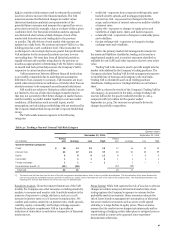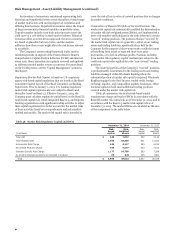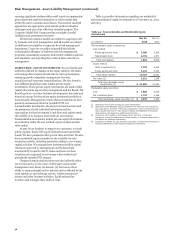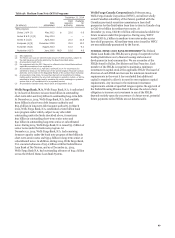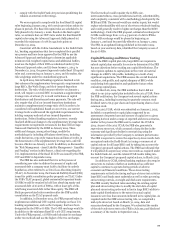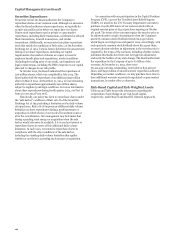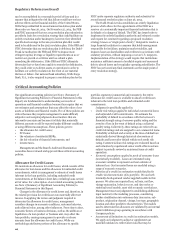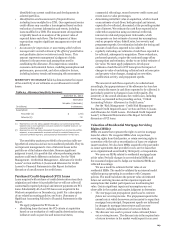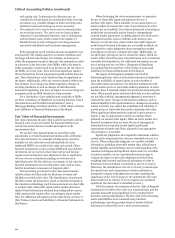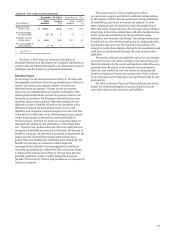Wells Fargo 2014 Annual Report Download - page 103
Download and view the complete annual report
Please find page 103 of the 2014 Wells Fargo annual report below. You can navigate through the pages in the report by either clicking on the pages listed below, or by using the keyword search tool below to find specific information within the annual report.• comply with the Dodd-Frank Act provision prohibiting the
reliance on external credit ratings.
We were required to comply with the final Basel III capital
rules beginning January 2014, with certain provisions subject to
phase-in periods. The Basel III capital rules are scheduled to be
fully phased in by January 1, 2022. Based on the final capital
rules, we estimate that our CET1 ratio under the final Basel III
capital rules using the Advanced Approach (fully phased-in)
exceeded the minimum of 7.0% by 343 basis points at
December 31, 2014.
Consistent with the Collins Amendment to the Dodd-Frank
Act, banking organizations that have completed their parallel
run process and have been approved by the FRB to use the
Advanced Approach methodology to determine applicable
minimum risk-weighted capital ratios and additional buffers,
must use the higher of their RWA as calculated under (i) the
Advanced Approach rules, and (ii) from January 1, 2014, to
December 31, 2014, the general approach under Basel III capital
rules and, commencing on January 1, 2015, and thereafter, the
risk weightings under the standardized approach.
In April 2014, federal banking regulators finalized a rule
that enhances the supplementary leverage ratio requirements for
large BHCs, like Wells Fargo, and their insured depository
institutions. The rule, which becomes effective on January 1,
2018, will require a covered BHC to maintain a supplementary
leverage ratio of at least 5% to avoid restrictions on capital
distributions and discretionary bonus payments. The rule will
also require that all of our insured depository institutions
maintain a supplementary leverage ratio of 6% in order to be
considered well capitalized. Based on our review, our current
leverage levels would exceed the applicable requirements for the
holding company and each of our insured depository
institutions. Federal banking regulators, however, recently
finalized additional changes to the supplementary leverage ratio
requirements to implement revisions to the Basel III leverage
framework finalized by the BCBS in January 2014. These
additional changes, among other things, modify the
methodology for including off-balance sheet items, including
credit derivatives, repo-style transactions and lines of credit, in
the denominator of the supplementary leverage ratio, and will
become effective on January 1, 2018. In addition, as discussed in
the “Risk Management - Asset/Liability Management - Liquidity
and Funding” section in this Report, a final rule regarding the
U.S. implementation of the Basel III LCR was issued by the FRB,
OCC and FDIC in September 2014.
The FRB has also indicated that it is in the process of
considering new rules to address the amount of equity and
unsecured debt a company must hold to facilitate its orderly
liquidation, often referred to as Total Loss Absorbing Capacity
(TLAC). In November 2014, the Financial Stability Board (FSB)
issued for public consultation policy proposals on TLAC. Under
the FSB’s TLAC proposal, global systemically important banks
(G-SIBs) would be required to hold loss absorbing equity and
unsecured debt of 16-20% of RWAs, with at least 33% of this
total being unsecured debt rather than equity. The FRB will
likely propose related rules sometime after the FSB’s public
consultation on the TLAC proposal ends.
In addition, in December 2014, the FRB proposed rules to
implement an additional CET1 capital surcharge on those U.S.
banking organizations, such as the Company, that have been
designated by the FSB as G-SIBs. The G-SIB surcharge would be
in addition to the minimum Basel III 7.0% CET1 requirement.
Under the FRB proposal, a G-SIB would calculate its surcharge
under two methods and use the higher of the two surcharges.
The first method would consider the G-SIB’s size,
interconnectedness, cross-jurisdictional activity, substitutability,
and complexity, consistent with a methodology developed by the
BCBS and FSB. The second would use similar inputs, but would
replace substitutability with use of short-term wholesale funding
and would generally result in higher surcharges than the BCBS
methodology. Under the FRB proposal, estimated surcharges for
G-SIBs would range from 1.0 to 4.5 percent of a firm’s RWAs.
The G-SIB surcharge would be phased in beginning on
January 1, 2016 and become fully effective on January 1, 2019.
The FSB, in an updated listing published in November 2014
based on year-end 2013 data, identified the Company as one of
the 30 G-SIBs.
Capital Planning and Stress Testing
Under the FRB’s capital plan rule, large BHCs are required to
submit capital plans annually for review to determine if the FRB
has any objections before making any capital distributions. The
rule requires updates to capital plans in the event of material
changes in a BHC’s risk profile, including as a result of any
significant acquisitions. The FRB assesses the overall financial
condition, risk profile, and capital adequacy of BHCs while
considering both quantitative and qualitative factors when
evaluating capital plans.
On March 26, 2014, the FRB notified us that it did not
object to our 2014 capital plan included in the 2014 CCAR. Since
the FRB notification, the Company took several capital actions
during 2014, including increasing its quarterly common stock
dividend rate to $0.35 per share and repurchasing shares of our
common stock.
Our 2015 CCAR, which was submitted on January 2, 2015,
included a comprehensive capital plan supported by an
assessment of expected uses and sources of capital over a given
planning horizon under a range of expected and stress scenarios,
similar to the process the FRB used to conduct the CCAR in
2014. As part of the 2015 CCAR, the FRB also generated a
supervisory stress test, which assumed a sharp decline in the
economy and significant decline in asset pricing using the
information provided by the Company to estimate performance.
The FRB is expected to review the supervisory stress results both
as required under the Dodd-Frank Act using a common set of
capital actions for all large BHCs and by taking into account the
Company’s proposed capital actions. The FRB has indicated that
it will publish its supervisory stress test results as required under
the Dodd-Frank Act, and the related CCAR results taking into
account the Company’s proposed capital actions, in March 2015.
In addition to CCAR, federal banking regulators also require
stress tests to evaluate whether an institution has sufficient
capital to continue to operate during periods of adverse
economic and financial conditions. These stress testing
requirements set forth the timing and type of stress test activities
large BHCs and banks must undertake as well as rules governing
stress testing controls, oversight and disclosure requirements.
The FRB recently finalized rules amending the existing capital
plan and stress testing rules to modify the start date of capital
plan and stress testing cycles and to limit a large BHC’s ability to
make capital distributions to the extent its actual capital
issuances were less than amounts indicated in its capital plan. As
required under the FRB’s stress testing rule, we completed a
mid-cycle stress test based on March 31, 2014, data and
scenarios developed by the Company. We submitted the results
of the mid-cycle stress test to the FRB in July 2014 and disclosed
a summary of the results in September 2014.
101


